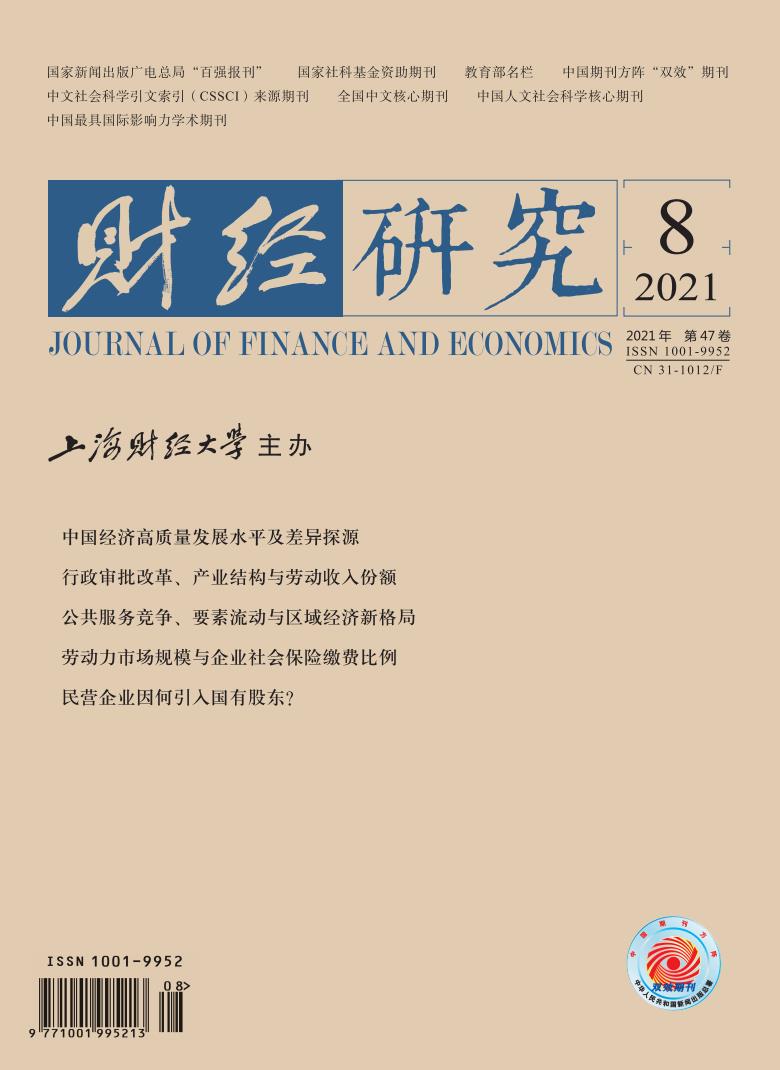作为企业经营成本的重要部分,过重的社会保险缴费负担直接降低了中小企业的参保意愿和缴费水平。这使得工业企业缴费水平可能低于政策缴费率,也导致不同企业之间实际缴费率存在差异,而且社会保险缴费可能增加了企业经营活动的负担。解决这些问题不仅有助于理解企业社会保险缴费的内在动机,而且有助于社会保险征收制度的顶层设计,并为供给侧结构性改革的“降成本”提供理论依据和实践参考。文章尝试研究这些问题,基于利润最大化框架,系统考察了劳动力市场规模与企业社会保险缴费比例的逻辑关系。理论分析表明,给定企业社会保险缴费具有改善劳动生产率和增加财务困境风险的双重作用,最优社会保险缴费比例应满足边际收益等于边际成本。伴随着劳动力市场规模扩张,再就业搜寻成本和工资构成中的解雇风险补偿下降,企业社会保险缴费引致的边际成本越小,均衡状态的最优社保缴费比例趋于向上调整。文章以行业就业容量衡量劳动力市场规模的计量结果显示,劳动力市场规模增加会显著提升企业社会保险缴费比例,并集中体现于行业内而非行业间,而且在高融资约束企业、高失业成本企业和民营企业更为凸显。进一步,企业社会保险缴费比例提升会显著降低其经营绩效,即成本效应占据主导地位。文章强调,企业社会保险缴费行为内生于所处的行业环境,在政策调整时需要加以考虑。
劳动力市场规模与企业社会保险缴费比例
摘要
参考文献
1 程欣, 邓大松. 社保投入有利于企业提高劳动生产率吗?−基于“中国企业−劳动力匹配调查”数据的实证研究[J]. 管理世界,2020,(3):90−100. DOI:10.3969/j.issn.1002-5502.2020.03.007
16 Agrawal A K, Matsa D A. Labor unemployment risk and corporate financing decisions[J]. Journal of Financial Economics,2013,108(2): 449−470. DOI:10.1016/j.jfineco.2012.11.006
17 Almeida H, Campello M, Weisbach M S. The cash flow sensitivity of cash[J]. Journal of Finance,2004,59(4): 1777−1804. DOI:10.1111/j.1540-6261.2004.00679.x
18 Almeida H, Philippon T. The risk-adjusted cost of financial distress[J]. Journal of Finance,2007,62(6): 2557−2586. DOI:10.1111/j.1540-6261.2007.01286.x
19 Brandt L, van Biesebroeck J, Zhang Y F. Creative accounting or creative destruction? Firm-level productivity growth in Chinese manufacturing[J]. Journal of Development Economics,2012,97(2): 339−351. DOI:10.1016/j.jdeveco.2011.02.002
20 Cai H B, Liu Q. Competition and corporate tax avoidance: Evidence from Chinese industrial firms[J]. Economic Journal,2009,119(537): 764−795. DOI:10.1111/j.1468-0297.2009.02217.x
21 Cui C Y, John K, Pang J R, et al. Employment protection and corporate cash holdings: Evidence from China’s labor contract law[J]. Journal of Banking and Finance,2018,92: 182−194. DOI:10.1016/j.jbankfin.2018.05.011
22 Diamond P A. Aggregate demand management in search equilibrium[J]. Journal of Political Economy,1982,90(5): 881−894. DOI:10.1086/261099
23 Fisman R, Svensson J. Are corruption and taxation really harmful to growth? Firm level evidence[J]. Journal of Develop- ment Economics,2007,83(1): 63−75. DOI:10.1016/j.jdeveco.2005.09.009
24 Gruber J, Krueger A B. The incidence of mandated employer-provided insurance: Lessons from workers’ compensation insurance[J]. Tax Policy and the Economy,1991,5: 111−143. DOI:10.1086/tpe.5.20061802
26 Henderson J V. Marshall’s scale economies[J]. Journal of Urban Economics,2003,53(1): 1−28. DOI:10.1016/S0094-1190(02)00505-3
27 Huang Z K, Li L X, Ma G R, et al. Hayek, local information, and commanding heights: Decentralizing state-owned enter- prises in China[J]. American Economic Review,2017,107(8): 2455−2478. DOI:10.1257/aer.20150592
29 John K, Lang L P H, Netter J. The voluntary restructuring of large firms in response to performance decline[J]. Journal of Finance,1992,47(3): 891−917. DOI:10.1111/j.1540-6261.1992.tb03999.x
30 Kim H. How does labor market size affect firm capital structure? Evidence from large plant openings[J]. Journal of Finan- cial Economics,2020,138(1): 277−294. DOI:10.1016/j.jfineco.2020.04.012
31 Lazear E P. Firm-specific human capital: A skill-weights approach[J]. Journal of Political Economy,2009,117(5): 914−940. DOI:10.1086/648671
32 Mares I. The sources of business interest in social insurance: Sectoral versus national differences[J]. World Politics,2003,55(2): 229−258. DOI:10.1353/wp.2003.0012
33 Nyland S, Smyth R, Zhu C J. What determines the extent to which employers will comply with their social security obli- gations? Evidence from Chinese firm-level data[J]. Social Policy and Administration,2006,40(2): 196−214. DOI:10.1111/j.1467-9515.2006.00484.x
34 Ofek E. Capital structure and firm response to poor performance: An empirical analysis[J]. Journal of Financial Economics,1993,34(1): 3−30. DOI:10.1016/0304-405X(93)90038-D
35 Serfling M. Firing costs and capital structure decisions[J]. Journal of Finance,2016,71(5): 2239−2285. DOI:10.1111/jofi.12403
引用本文
刘媛媛, 封进, 刘贯春. 劳动力市场规模与企业社会保险缴费比例[J]. 财经研究, 2021, 47(8): 64-78.
导出参考文献,格式为:






 5836
5836  6842
6842

